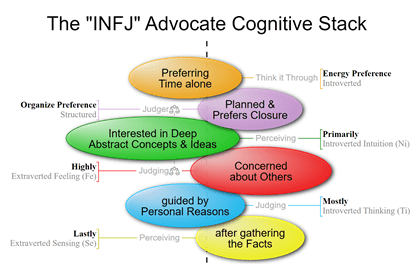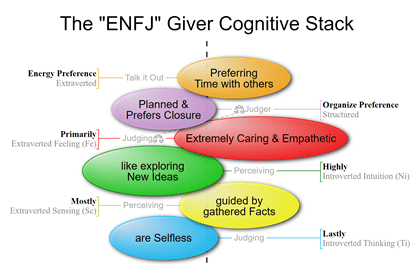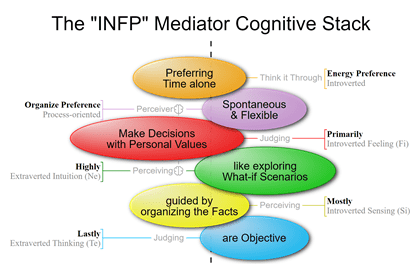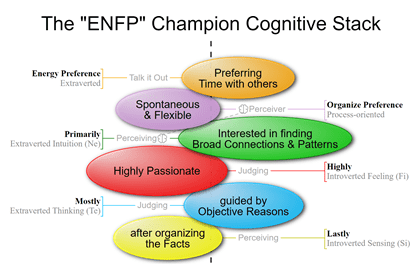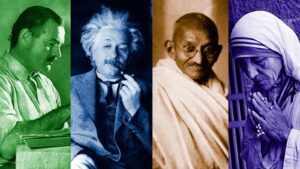
What is the Keirsey “Idealist” Personality Temperament?
Idealists have an Abstract Communication Style and a Cooperative Action Style. They talk primarily about what they hope for and imagine might be possible for people. Idealists want to act in good conscience, always trying to reach their goals without compromising their code of ethics.
- Idealists are enthusiastic, trust their Intuition, and dream of attaining wisdom.
- Idealists yearn for romance, seek their true selves, and prize meaningful relationships.
- Idealists pride themselves on being loving, kindhearted, and authentic.
- Idealists tend to be giving, trusting, and spiritual, focused on personal journeys and human potential.
- Idealists make intense mates, nurturing parents, and inspirational leaders.
- Idealists’ most excellent natural ability is diplomacy.
- An idealist is best if you need someone to clarify, unify, or inspire.
- Idealists are generally right-brain dominant.
- NTs and NPs each make up 12% of the rest of the population.
Keirsy Idealist Personality Type cross-reference
- Temperament Type – Phlegmatic
- Animal Type – Otter
- DISC Type – Influential
- Socio-Communicative Type – Expressive
- True Colors – Blue
- Color Code – Blue
- Personality Compass – West
- Occupational Type – Artistic
- Learning Type – Theorist
- Leadership Type – Collaborator
Keirsy Idealist Correlated MBTI Intuitive/Feeling (NF) Types
Keirsey classified the Idealist as Abstract/Intuition with Feeling (xNFx) MBTI Personality Types. These are the Types with Intuition and Feeling as the first Dominant or second Auxiliary Functions in either order.
- The Counselor (INFJ) is a mentor who excels in developing and guiding.
- The Teacher (ENFJ) is a mentor who excels in developing and educating.
- The Healer (INFP) is an advocate who excels in mediating and conciliating.
- The Champion (ENFP) is an advocate who mediates and motivates.
INFJ and ENFJ Judging MBTI Types are Idealists. In either order, they have Introverted Intuition and Extraverted Feelings as the first Dominant or second Auxiliary Functions.
INFP and ENFP-perceiving MBTI Types are Idealists. They have Extrovert Intuition and Introverted Feelings as the first Dominant or second Auxiliary Functions in either order.
Keirsy Idealist Enneagram Types
- Type 1 – The Reformer (ENFJ, INFJ)
- Type 4 – The Individualist (INFJ, INFP)
- Type 7 – The Enthusiast (ENFP)
- Type 9 – The Peacemaker (INFP)
What are the Keirsy Personality Temerpaments?

David Keirsey, born in 1921, was an American psychologist specializing in conflict management and family counseling. He began researching human behavior and Personality in the 1940s.
Keirsey blended the Myers-Briggs Personality Types with Ernst Kretschmer’s model of the Four Temperaments, developing the Keirsey Temperament Sorter, which was made famous by his book “Please Understand Me.”
Instead of using the term Personality, Keirsey used Temperament. He viewed it as a configuration of observable Personality Traits, communication habits, patterns of action, characteristic attitudes, values, and talents. To Keirsy, Temperament encompasses personal needs, individual contributions, workplace contributions, and societal roles.
Keirsey organized his Four Temperaments as a matrix and named them as suggested by Plato: Artisan (Iconic), Guardian (Pistic), Idealist (Noetic), and Rational (Dianoetic).
The matrix is divided in half vertically by Communication Styles: Concrete versus Abstract. The matrix is divided horizontally into two action styles: Cooperative and Utilitarian.
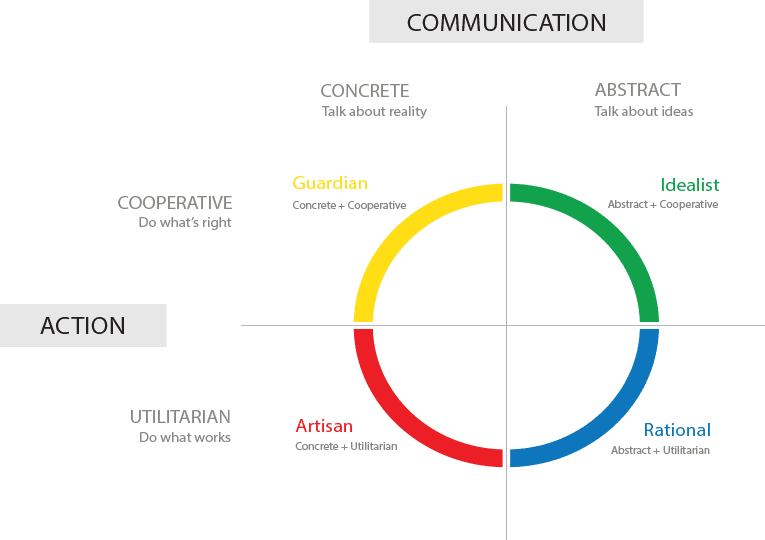
Learn more about the Keirsey Temperaments.
Concrete versus Abstract Communication Style
Some people are focused and like to talk primarily about the external, concrete world of everyday reality: facts and figures, their work, home, family, the news, sports, and weather—all the who, what, when, where, and how things in their lives.
Other people primarily like to talk about the internal, abstract world of ideas: theories and conjectures, dreams and philosophies, beliefs and fantasies — all the whys, ifs, and what might be in life.
For the most part, Concrete people talk about reality, while Abstract people talk about ideas.
According to Keirsey, everyone can engage in both observation and introspection. People are observant when they touch objects or otherwise perceive the world through their five senses. When people reflect and focus on their internal world, they are introspective.
However, individuals cannot simultaneously engage in observation and introspection. A person’s behaviors are directly affected by the extent to which they are more observant or reflective.
Observant people focus on practical matters such as food, shelter, and their immediate relationships. Carl Jung used “Sensation” to describe people who prefer Concrete perception.
Reflective people are more ‘head in the clouds’ and abstract in their views. They focus on global or theoretical issues such as equality or engineering. Carl Jung used the word Intuition when describing people who prefer Abstract perception.
Keirsey’s two Communication Styles, Abstract versus Concrete, are similar to the Myers-Briggs “Perceiving” Cognitive Functions, Intuition (Abstract) and Sensing (Concrete).
Cooperative versus Utilitarian Action Style
Some people act practically and pragmatically; that is, they do what gets results, what achieves their objectives as effectively or efficiently as possible. They only check afterward to see if they observe the rules or go through the proper channels. People with this behavior have a Utilitarian Action Style.
On the other hand, some people act primarily cooperatively and socially acceptable; they try to do the right thing in keeping with agreed-upon social rules, conventions, and codes of conduct. Only later do they concern themselves with the effectiveness of their actions. People with this behavior have a Cooperative Action Style.
Utilitarian people mostly do what works, while Cooperative people do what’s right.
Cooperative-type people pay more attention to other people’s opinions and are more concerned with doing the right thing. Meanwhile, Utilitarian-type people pay more attention to their thoughts or feelings and are more concerned with doing what works.
The two Cooperative Temperaments are the Idealists (Cooperative and Abstract) and Guardians (Cooperative and Concrete).
The two Utilitarian Temperaments are the Rational (Pragmatic and Abstract) and the Artisan (Pragmatic and Concrete).
Neither the MBTI nor Jung has a corresponding or comparable dichotomy to the Keirsey Action Style classification. Action Style significantly differs between Keirsey’s Temperaments and Myers and Jung’s work in Cognitive Personality Styles.
Keirsy Idealist Personality Temperament
Idealists, as a temperament, are passionately concerned with personal growth and development. Idealists strive to discover who they are and how to become their best selves.
Idealists are on a quest for self-knowledge, and self-improvement drives their imagination. They are naturally drawn to working with others and want to help. Idealists believe in giving of themselves to help others; they cherish a few warm, sensitive friendships.
Whether in education or counseling, social services or personnel work, journalism or the ministry, they are gifted at helping others find their way in life, often inspiring them to grow and fulfill their potential.
Idealists are sure that friendly cooperation is the best way for people to achieve their goals. Conflict and confrontation upset them because they create angry barriers between people.
Idealists dream of creating harmonious, even caring, personal relations. They have a unique talent for helping people get along and work together for the good of all.
Such interpersonal harmony might be a romantic ideal, but Idealists are incurable romantics who prefer to focus on what might be rather than what is.
The natural, practical world is only a starting place for Idealists. Idealists believe in possibilities waiting to be realized, rich with meanings calling out to be understood.
This idea of a mystical or spiritual dimension to life, the “not visible” or the “not yet” that can only be known through Intuition or by a leap of faith, is far more important to Idealists than the world of material things.
Idealists are highly ethical and adhere to a strict standard of personal integrity. They must be true to themselves and others. However, Idealists are more often the very soul of kindness, filled with love and goodwill, particularly in their relationships.
Idealists strive for a special rapport with their children and in marriage. They wish to find a “soulmate, ” someone with whom they can bond emotionally and spiritually, sharing their deepest feelings and complex inner worlds.
Idealists are relatively rare, making up no more than 15 to 20 percent of the population. However, their ability to inspire people with enthusiasm and idealism has given them influence far beyond their numbers.
Famous Idealists
Princess Diana, Joan Baez, Albert Schweitzer, Bill Moyers, Eleanor Roosevelt, Mohandas Gandhi, Mikhael Gorbachev, and Oprah Winfrey are examples of Idealists.

